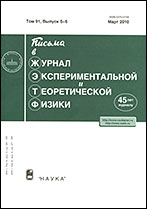|
|
Pis'ma v Zhurnal Èksperimental'noi i Teoreticheskoi Fiziki, 2006, Volume 84, Issue 5, Pages 334–338
(Mi jetpl1133)
|
 |
|
|
This article is cited in 6 scientific papers (total in 6 papers)
CONDENSED MATTER
Effect of dipole forces on the structure of the liquid phases of DNA
V. L. Goloa, E. I. Katsbc, I. P. Kikot'a
a M. V. Lomonosov Moscow State University, Faculty of Mechanics and Mathematics
b Institute for Theoretical Physics, Russian Academy of Sciences
c Institut Laue-Langevin
Abstract:
The dipole-dipole contribution to the energy of the pair interaction between DNA molecules has been calculated and analyzed. Rigid fragments of DNA, i.e., of a length of about the persistent length, which have discrete dipole moments of base pairs, are considered. For a given distance between the centers of mass of molecules, the energy of the dipole-dipole interaction is a function of three angular variables; the angles ϕ1 and ϕ2 between the central dipoles of both molecules and the z axis passing through the centers of the molecules, as well as the angle ξ between long axes of the molecules, are taken as these variables. It is shown that the dipole energy has minima when the mutual orientation of the molecules satisfies one of the following conditions: (i) ϕ1 = ϕ2 = 0 or (ii) ϕ1 = ϕ2 = π. The cholesteric twist angle ξ can be both positive and negative in dependence on the type of the minimum. For realistic cholesteric dispersion parameters, the dipole energy is only slightly lower than the experimentally known binding energy of the molecules in dispersion. The results allow the assumption that the dipole forces significantly affect the structure and other properties of DNA suspensions; in particular, they can lead to nontrivial texture phenomena, biaxial correlation, and multistability.
Received: 01.08.2006
Citation:
V. L. Golo, E. I. Kats, I. P. Kikot', “Effect of dipole forces on the structure of the liquid phases of DNA”, Pis'ma v Zh. Èksper. Teoret. Fiz., 84:5 (2006), 334–338; JETP Letters, 84:5 (2006), 275–279
Linking options:
https://www.mathnet.ru/eng/jetpl1133 https://www.mathnet.ru/eng/jetpl/v84/i5/p334
|


| Statistics & downloads: |
| Abstract page: | 189 | | Full-text PDF : | 104 | | References: | 39 |
|





 Contact us:
Contact us: Terms of Use
Terms of Use
 Registration to the website
Registration to the website Logotypes
Logotypes








